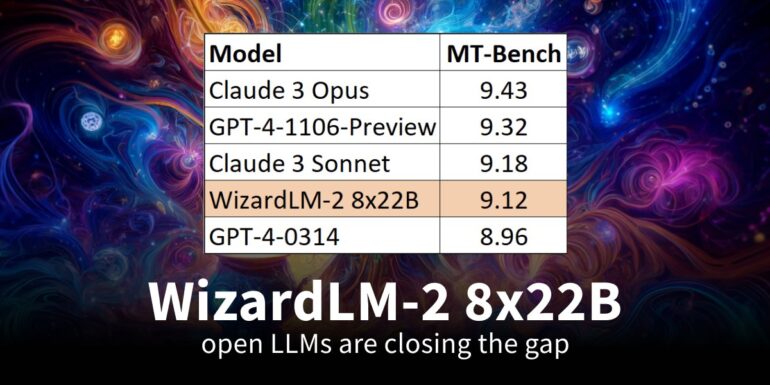- AI researchers introduce WizardLM-2, a series of open-source large language models.
- Three models: WizardLM-2 8x22B, WizardLM-2 70B, and WizardLM-2 7B, tailored for diverse tasks.
- Extensive research led to enhanced comprehension abilities, with outstanding performance in chat, multilingual processing, reasoning, and agency representation.
- WizardLM-2 8x22B is identified as the pinnacle of open-source LLMs, while WizardLM-2 70B excels in reasoning tasks.
- Methodologies include AI-powered synthetic training and the “AI Align AI” (AAA) framework for collaborative learning.
- Rigorous evaluations confirm WizardLM-2’s capabilities surpassing even GPT-4.
Main AI News:
In a groundbreaking move, a team of AI researchers has unveiled WizardLM-2, a revolutionary series of open-source large language models. This unveiling marks a pivotal moment in the realm of artificial intelligence, heralding a new era of possibilities. Comprising three distinct models – WizardLM-2 8x22B, WizardLM-2 70B, and WizardLM-2 7B – this series represents a quantum leap forward in machine learning capabilities, each tailored to tackle diverse and intricate tasks with unparalleled efficiency.
The introduction of WizardLM-2 signifies a culmination of relentless dedication and innovation by the research team, spanning over a year of intensive development. Their tireless efforts have resulted in models that boast exceptional proficiency across various domains, from adept conversation handling to multilingual processing, intricate reasoning, and adept agency representation. Notably, these models stand shoulder to shoulder with the most sophisticated proprietary large language models (LLMs) currently in circulation.
At the forefront of this series stands WizardLM-2 8x22B, hailed as the epitome of open-source LLMs for tackling multifaceted challenges. Meanwhile, WizardLM-2 70B shines in its prowess in reasoning tasks, offering unparalleled depth in cognitive processing capabilities. Surprisingly, WizardLM-2 7B, despite its relatively smaller size, emerges as a formidable contender, boasting rapid response times and remarkable performance that rivals models of significantly larger scales. Each model within the WizardLM-2 series brings its own unique strengths, catering to a wide array of applications and requirements.
The development of WizardLM-2 was underpinned by cutting-edge methodologies and training techniques aimed at optimizing performance and efficiency. Leveraging a sophisticated AI-powered synthetic training system, the team implemented progressive learning strategies, enabling the models to evolve and adapt with minimal data requirements. Furthermore, the adoption of the “AI Align AI” (AAA) framework fostered a collaborative ecosystem wherein these models engaged in simulated interactions and peer learning, amplifying each other’s capabilities to unprecedented levels.
In rigorous evaluations encompassing both human and automated assessments, WizardLM-2 emerged triumphant, showcasing performance levels that either matched or surpassed those of industry-leading models like GPT-4. This validation underscores the unparalleled efficacy and potential of WizardLM-2, cementing its status as a formidable force in the realm of open-source AI models.
Conclusion:
The introduction of WizardLM-2 signifies a monumental shift in the landscape of open-source AI models. With unparalleled performance and versatility, WizardLM-2 poses a significant challenge to proprietary models like GPT-4. This development heralds a new era of accessibility and innovation in artificial intelligence, empowering businesses and researchers alike to harness the full potential of advanced language models for a myriad of applications.

